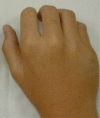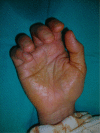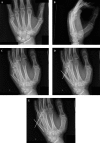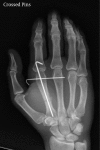Metacarpal Neck Fractures: A Review of Surgical Indications and Techniques
- PMID: 27800460
- PMCID: PMC5078834
- DOI: 10.5812/atr.32933
Metacarpal Neck Fractures: A Review of Surgical Indications and Techniques
Abstract
Context: Hand injuries are a common emergency department presentation. Metacarpal fractures account for 40% of all hand fractures and can be seen in the setting of low or high energy trauma. The most common injury pattern is a metacarpal neck fracture. In this study, the authors aim to review the surgical indications for metacarpal neck fractures, the fixation options available along with the risk and benefits of each.
Evidence acquisition: Literature review of the different treatment modalities for metacarpal neck fractures. Review focuses on surgical indications and the risks and benefits of different operative techniques.
Results: The indications for surgery are based on the amount of dorsal angulation of the distal fragment. The ulnar digits can tolerate greater angulation as the radial digits more easily lose grip strength. The most widely utilized fixation techniques are pinning with k-wires, dorsal plating, or intramedullary fixation. There is currently no consensus on an optimal fixation technique as surgical management has been found to have a complication rate up to 36%. Plate and screw fixation demonstrated especially high complication rates.
Conclusions: Metacarpal neck fractures are a common injury in young and active patients that results in substantial missed time from work. While the surgical indications are well-described, there is no consensus on the optimal treatment modality because of high complication rates. Dorsal plating has higher complication rates than closed reduction and percutaneous pinning, but is necessary in comminuted fractures. The lack of an ideal fixation construct suggests that further study of the commonly utilized techniques as well as novel techniques is necessary.
Keywords: Bone Wires; Fracture Fixation, Internal; Hand; Metacarpal Bone; Neck Fractures.
Figures










References
-
- Day C, Stern PJ. Fractures of the Metacarpals and Phalanges. 6th ed. Philadelphia: Elsevier Churchill Livingstone; 2011. - DOI
-
- Ashkenaze DM, Ruby LK. Metacarpal fractures and dislocations. Orthop Clin North Am. 1992;23(1):19–33. - PubMed
-
- Diao E. Metacarpal fixation. Hand Clin. 1997;13(4):557–71. - PubMed
Publication types
LinkOut - more resources
Full Text Sources
Other Literature Sources
